Madhava Nidana Chapter 59 Netra Roga Nidanam
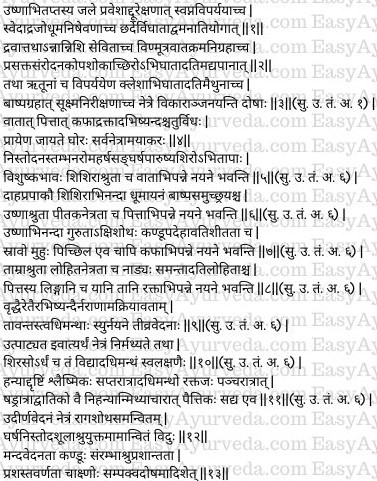
This article explains Madava nidana 59th chapter “Netra Roga Nianam”. Causes, pathology and symptoms of Netra Roga are explained in this chapter. Netra Roga means diseases of eye.
Table of Contents
Netra Roga Samanya Hetu

General Causes of Eye Diseases
Entering into the water (taking bath in cold water) immediately after exposure to heat, seeing objects which are far away (by straining one’s eyes), abnormal sleeping habits (like not sleeping at proper time, keeping awake during night time, sleeping in excess during day time etc), sudation or fumigation to the eyes, excessive contact / exposure of the eyes to dust and smoke, forcibly withholding the urge for vomiting or vomiting in excess (too much vomiting, too much of emesis therapy), taking watery foods (liquid foods) at night in excess, habitually suppressing the natural urges of faeces, urine and flatus, constantly weeping, getting angry and grieving, injury to the head, excessive consumption of alcoholic drinks, abnormal seasonal changes, physical and mental exhaustion, excessive indulgence in sexual act, controlling tears, seeing minute objects (microscopic objects) for prolonged periods of time, etc are the etiological factors of eye disorders. The above-mentioned etiological factors cause abnormal increase of doshas which in turn produce various diseases of the eyes. (1-3)
Read – Eye Diseases Causes, Pathogenesis, Symptoms, Treatment, Herbs
Types of Abhisyanda
Abhsyanda is of four types – vātaja, pittaja, kaphaja and raktaja. It is a very dreadful disease which probably is the main cause for all other (almost) eye diseases. (4)
Vataja Abisyanda
Symptoms of Abisyanda caused by increased vata include pricking pain, stiffness (loss of movements or restricted movements), horripilation, irritation and roughness (friction) in the eyes, headache, absence of excretions in the eyes (dryness of eyes) and cold tears flowing out of the eyes. (5)
Pittaja Abhishyanda
Symptoms of Abisyanda caused by increased pitta include feeling of burning sensation, suppuration, desire for cold things and comforts, feeling as if hot smoke is being eliminated from the eyes, excessive flow of tears, hot tears coming from the eyes and yellowish discolouration of the eyes. (6)
Kaphaja Abhisyanda
Symptoms of Abhisyanda caused by increased kapha include desire for warm things and comforts, feeling of heaviness in the eyes, swelling, itching, accumulation of dirty excretions, excessive coldness, excessive and frequent discharge of sticky secretions (discharges, tears) from the eyes. (7)
Read – Chaturvidha Netra Srava – 4 types of eye discharges, symptoms, treatment
Raktaja Abhishyanda
Symptoms of Abhisyanda caused by increased rakta (blood) include discharge of copper-coloured tears, redness of the eyes, redness of the capillaries in all corners of the eyes and presence of other symptoms of pittaja abhisyanda (explained above). (8)
Adhimantha
Any of the above types of abhişyanda, if not treated at the proper time, will undergo abnormal increase and lead to another condition called as adhimantha which causes severe pain in the eyes. (9)
Read – Adhimantha – Meaning, Causes, Types, Symptoms, Treatment
Adhimantha Samanya Lakshana
General symptoms of Adhimantha
A condition of the eye in which the person feels as though someone is pulling out or churning (squeezing) his eyes and half portion of his head with force is known as adhimantha. In addition to this the other symptoms of predominant doshas (as explained in dosha types of abhisyanda above) are also seen in this condition. (10)
Effect of Adhimantha
When improperly managed and not treated properly at proper time –
Kaphaja Adhimantha will destroy the vision within seven days.
Raktaja Adhimantha will destroy the vision within five days.
Vataja Adhimantha will destroy the vision within six days.
Pittaja Adhimantha will destroy the vision immediately / very soon (within three days). (11)
Read – Classification of Eye Diseases As Per Ayurveda
Sama Lakshanas of Netra Roga
Symptoms of eye diseases associated with ama (unripe stage)
The symptoms of ama (unripe) stage of eye diseases include progressively increasing severe pain, redness, swelling and rubbing pain (friction, irritation), pricking pain, pain, and discharges (excessive flow of tears) from the eyes. (12)
Pakva Lakshanas of Netra Roga
Symptoms of eye diseases devoid of ama association (ripe stage)
The symptoms of pakva (ripe) stage of eye diseases include mild pain (reduction in severity of pain) in the eyes, itching, swelling, reduction of discharges (tears) from the eyes, colour of the eyes (discolouration) returning to normal. (13)
Sothaja Netrapaka
In this condition the eyes will have itching, accumulation of excretion / dirt (in the eyes), excessive tearing, and will resemble the ripe Udumbara fruit. Suppuration will occur following the appearance of swelling.
Read – Watery Eyes: Causes, Ayurvedic Treatment, Remedies
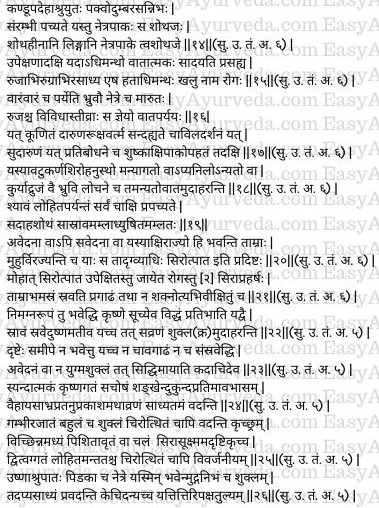
Asotha Netrapaka
In this condition all symptoms mentioned above (in sothaja netrapaka) will be found except the appearance of swelling (suppuration of eyes occur even without the appearance of swelling). (14)
Hatadimantha
When neglected (not properly treated at proper time), the Vataja Adhimantha forcefully causes severe pain in the eyes and leads to destruction of vision. This incurable disease is known as Hatadhimantha. (15)
Vataparyaya
A condition in which vata which has abnormally increased repeatedly causes different kinds of pain in the eyebrows and eyes (areas surrounding the eyes) is called as Vataparyaya. (16)
Sushka aksipaka
The condition in which the eyelids become closed, hard and dry to touch, has burning sensation, is cloudy and unclear vision, and it becomes difficult to open the eyelids and on opening the eyes look dry is known as Suska Aksipaka. (17)
Read – Akshipakatyaya, Ajakajata Eye Disorder – Definition, Symptoms, Treatment
Anyatovata
A condition in which vata aggravating in the posterior part of the neck, ears, head, jaw (lower) and sides of the neck causes severe pain in the eyebrows and eye is known as Anyatovata. (18)
Amladhyusita
The condition in which the pitta undergoing abnormal increase due to excessive consumption of sour foods would cause bluish discolouration of the eyes with reddish borders and suppuration in the entire eye is known as Amladhyusita. This condition is also associated with burning sensation, swelling and discharges (excessive flow of tears) from the eyes. (19)
Sirotpata
The disease in which the network of blood vessels in the eye become coppery or red in colour, is associated or not associated with pain and the eye becomes angry red repeatedly is known by the name Sirotpata. (20)
Sirapraharsa
When sirotpata disease (explained above) is neglected (not treated promptly) due to ignorance, yet another disease known as Sirapraharsa gets manifested. In this condition the person would discharge thick coppery / red coloured fluids in large quantities and will be unable to see anything. (21)
Read – Arjuna, Pishtaka Eye Disorders – Definition, Symptoms, Treatment
Savrana Sukla
A deep-seated spot which is difficult to identify, which appears as if pierced by a sharp needle, located in the black of the eye (cornea) is known as Savrana Sukla or Savrana Sukra. In this condition, very hot tears discharge (tears) flow out of the eyes. (22)
Savrana Sukla
An ulcer which is not very near to the pupil, which is not deep rooted, not having too much of discharge, is painless (has mild pain) and which doesn’t have two ulcers (not affecting both eyes together) and is sometimes curable (sometimes responds to treatment and sometimes will not, especially if both eyes are afflicted with ulcers) is known as Savrana Sukla or Savrana Sukra. (23)
Symptoms of Curability of Avrana Sukla
Due to the effect of Abhisyanda there appears a white coloured scar resembling the colour of conch, moon or lily flower on the cornea or the cornea appears cloudy, as if it is covered by thin (waterless) cloud, and is associated with burning sensation. This condition is known as Avrana Sukla which is easily curable. (24)
Read – Netra Shuklagata Rogas – Disorders Affecting Sclera
Prognosis of Avrana Sukla
Avranaśukla developing from deep inside (second or third layer / tunic), is thick, and has been for a long time (has become chronic) is difficult to cure.
Avrana Sukla in which there is a tear in the middle or is covered by muscle, movable, and is minute / invisible (interferes with vision) because of being enveloped with a thin network of veins should be refused treatment since it is incurable.
Avrana Sukla occurring (involving) in the second layer, having reddish edges and has become chronic is also incurable.
Similarly, avrana sukla in which warm tears are eliminated from the eyes, there is appearance of white coloured nodules of the size of green gram and that which assumes the colour of feather of tittira bird (grey partridge) should also be considered as incurable. (25-26)
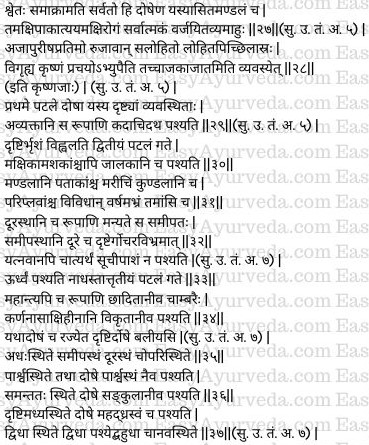
Akshipakatyaya
The eye disease in which the entire cornea becomes white (in colour) by the action of all the three abnormally increased doshas, caused by all three aggravated doshas should be rejected treatment (because it is incurable). (27)
Read – Akshipakatyaya, Ajakajata Eye Disorder – Definition, Symptoms, Treatment
Ajakajaata
A growth (projection) resembling a dried pellet of goat excreta, which is painful, red in colour, discharges red sticky fluid, and projects out piercing the cornea is called as Ajakajata. (28)
Pratama Patalagata Timira
When timira manifests due to the increased doshas localized in the first patala (layer) of the drsti (lens), the person sees things in an indistinct or unclear way (does not see the objects clearly). (29)
Dwitiya Patalagata Timira
When the timira manifests due to the increased doshas getting localized (invade the) in the second patala (layer), his vision becomes distorted. He sees flies, mosquitoes, spider webs, round things (circular objects), flags, various types of shining things like rays of light etc, rings, jumping frogs etc, rain, clouds, and darkness. He sees distant objects to be very near to him and nearby things to be very far away due to distortion and perversion of vision and visual objects. In spite of making all efforts the person will not be able to see the eye of the needle and its thread (will not be able to put the thread into the eye of the needle). (31-32)
Trtiya Patalagata Timira
- When the timira manifests due to the increased doshas getting localized (invade the) in the third patala (layer), the person will be able to see objects which are at the top but cannot see the objects placed at the bottom. Even the larger objects appear to him as though covered by cloth. He sees the other people as being devoid of ears, nose and eyes or sees them (ears, nose and eyes) as abnormal and distorted. Depending on the doshas which become predominant in the disease, the colour corresponding to that particular predominant dosha will manifest in the drsti – lens.
- When the doshas get localized in the lower portion of the drsti (lens) one cannot see the objects which are nearby. If the doshas are located in the upper portion, one cannot see the objects which are far away. When the doshas are localized at the sides, one cannot see the objects which are on the sides.
- If doshas are spread all over, in all directions, the objects will be seen as mixed up in different ways. On the other hand, if the doshas are located at the centre, the big objects are seen as small by the patient. If the doshas are located in two places, all the objects appear double. If the doshas are located in many places, all objects appear to be of many types. If the doshas are located obliquely in the drsti, the person sees one object as two. (33-37)
Read – Ametropia Meaning, Causes, Symptoms, Prognosis, Treatment
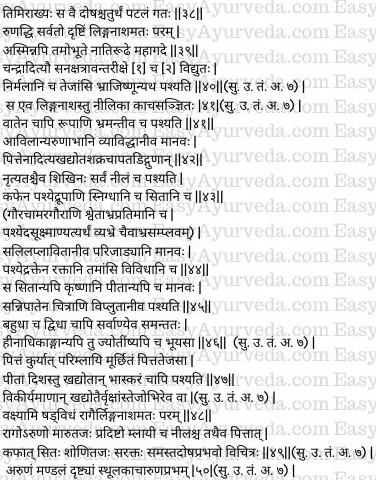
Chaturtha Patalagata Timira
When the same increased doshas of (having the form of) timira located in the third patala (layer) reaches to invade the fourth patala (layer), they cause complete loss of vision. This condition is called Linganasa (loss of capacity to see and perceive the objects – total loss of vision).
If this dreadful disease which is in the form of darkness is not deep rooted or if it has not run a long course and become chronic (much time has not lapsed since the onset of blindness), the person will be able to see very bright objects such as the moon, sun, stars and lightning in the sky and also other clear bright objects elsewhere. This linganasa is also known as Nilika or Kaca. (38-40)
Timira Symptoms based on ‘predominant dosha’ involved
Vataja Timira – In timira, when vata is predominant, the patient sees the objects constantly moving in front of his eyes. The objects are perceived as being dirty, of slightly red (reddish yellow) in colour and crooked (irregular or broken).
Pittaja Timira – In timira, when pitta is predominant, the patient sees the (shapes, forms of) sun, glow-worm, rainbow, and sparks of fire and dancing peacocks – all objects blue in colour.
Kaphaja Timira – In timira, when kapha is predominant, the patient sees all objects as being unctuous and white in colour and very big in size. He sees a clear sky as if covered by clouds. He sees all the objects being drowned in the water and devoid of any movement (still and stagnant).
Raktaja Timira – In timira, when rakta (vitiated blood) is predominant, the person sees all the objects red in colour. He also would see different types of darkness (darkness of varying intensity). Even the white coloured objects are seen as being black or yellow coloured.
Sannipataja Timira – In timira caused by predominance of all the three doshas, the person sees different objects and also strange objects and in different forms (not in their actual form) with many colours and irregularities. He sees one object as many (all objects everywhere) or one object as two or many (many mingled into one). He sees people etc with absence of some body parts or with extra parts. He also sees the stars as being deformed. (41-46)
Read – Ayurveda Treatment of Day Blindness and Night Blindness
Parimlayi Kaca
Pitta in association with blood produces another condition known as Parimlayi. In this condition, the patient sees yellow in everything and everywhere. He also sees glow worms and sun here and there (at any time). He sees trees surrounded by glow worms, fire or any other shining things. (47)
Types of Linganasa
Further on, I will describe six types of linganāśas pertaining to (based on) colours.
Manifestation of different colours in different types of doshaja linganasa
In timira / linganāśa caused by increased vata, all objects will appear crimson red in colour.
In linganasa caused by increased pitta, all the objects will appear yellowish blue or blue in colour.
In linganasa caused by increased kapha, all the objects will appear white in colour.
In linganasa caused by increased blood, all objects will appear red in colour.
In linganasa caused by all the three doshas increased together, all objects will appear to have strangely mixed colours. (49)
The crimson red colour described (for vātaja linganāśa) will be like bright circular rings as seen coming out of a thick lens. (50)
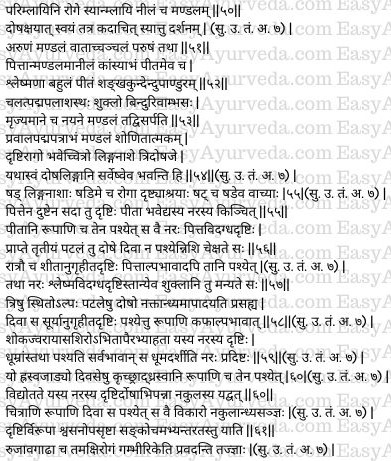
Specific features of Parimlayi
In parimlaayi, lens becomes dirty and blue coloured. Sometimes when the doshas decrease on their own accord in due course of time, the person regains sight even without any treatment. (50)
Symptoms of coloured lens in accordance to dosha predominance
- In case of increase of vata, the vision / lens become crimson in colour, unsteady and rough (irregular).
- In case of increase of pitta, the lens becomes blue, whitish yellow like bronze and yellow in colour.
- In case of increase of kapha, the lens becomes thick, yellow or of the colour (resemblance) of conch, jasmine flower or moon, whitish yellow in colour or white in colour resembles a drop of water on a moving lotus leaf. The lens moves here and there while rubbing the eyes.
- In case of increase of rakta – blood, the rings (lens) will resemble coral or leaf of red coloured lotus.
- In case of increase of all the three doshas together, the rings (lens) will be of mixed colours. The other symptoms in this condition will be in accordance to the predominance of particular dosha in the combined vitiation. (51-54)
To sum up
Six types of Linganasas occur in the eye as explained above. Six other diseases affecting the lens (vision) will be detailed further on. (55)
Read – Amblyopia Symptoms, Causes, Treatment, Ayurveda Concept
Pitta Vidagdha Dristi
If the drsti (lens, vision) due to the influence of vitiated pitta always remains slight yellowish in color, the person starts seeing everything in his surrounding as being yellow in colour. This condition is called as pitta vidagdha drsti (also called divandhya – day blindness). If pitta gets localized in the third patala (layer) of drsti mandala (eye, lens) the person cannot see any objects during day time. He can only see things during night time. Due to the influence of coldness prevailing at night, the pitta gets subsided and hence he can see things during night time. (55-56)
Read – Day Blindness Causes, Symptoms, Treatment, Ayurveda Understanding
Kapha Vidagdha Drushti
Similarly, when the drsti (lens, vision) of the person is afflicted by vitiated kapha, the person sees everything (all objects) as white (in colour). When the doshas get lodged in all the three patalas (layers), the person would suffer from a condition called naktandhya (night blindness). In the day time, due to less quantity of kapha and due to the influence of (heat of) the Sun, he can see the objects properly. This condition is called as Kaphavidagdha Drsti or Naktandya which means night blindness. (57-58)
Read – Night Blindness Causes, Symptoms, Treatment, Ayurveda Concept
Dhumadarsi
Drsti (lens, vision) getting affected by causes such as grief, fever, excessive exertion and headache etc leads to the manifestation of a disease called Dhumadarsi in which the person sees all objects as if covered by smoke. (59)
Hrsvajadya
The disease in which the person finds it very difficult to see the objects during daytime and also sees big objects as small is known as Hrasvajādya. (60)
Nakulandhya
When all the three vitiated doshas affect the drsti (vision, lens) the eyes of the person shine like the eyes of mongoose. Such a person sees objects in different (mixed) shapes and colours. This condition is known as Nakulandhya. (60)
Read – Nakulandhya / Nakula Drishti Meaning, Symptoms, Treatment
Gambhirika
The drsti (lens, vision, eyes) affected by vitiated vata makes the eye deformed (sees things in unnatural state) and the eyeball sinks deep inside the socket of the eye. In this condition there is severe pain in the eye. This disease is called Gambhirika by experts. (61)
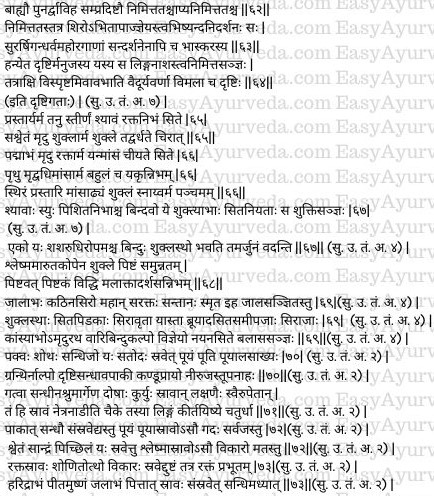
Agantuja Linganasha
Agantuja Linganasa (that caused by external agents) is of two types. They are – Nimittaja Linganasa and Animittaja Linganasa.
Nimittaja Linganasa – Linganasa caused due to headache (caused by etiological factors like poisons, smell of flowers, exposure to severe winds etc) is called as Nimittaja Linganasa. This will have symptoms similar to those of Abhisyanda (conjunctivitis).
Animittaja Linganasa – Loss of vision caused due to unusual (sudden) sight of gods, sages, gandharvas, divine serpents, or the Sun is known as Animittaja Linganasa. In this condition the eyes are quite normal and not deformed. The lens too will be bright and will have the colour and glitter of vaidurya (Cat’s Eye) and clear (but they would have lost the capacity to see and perceive). (62-64)
Prastaryarma (Prastari Arma)
A thin, broad, black or blackish blue or red coloured mass of tissue (fleshy growth) formed on the white of the eye (sclera – sita mandala) is known as Prastaryarma. (65)
Read – Pterygium – Arma Eye Disorder – Symptoms, Ayurveda Treatment
Shuklarma
A white soft mass (fleshy strip), developing slowly (over many days) on the white portion of the eye (sclera) is known as Shuklarma (Sukla Arma). (65)
Rakta Arma
A soft muscular tissue / strip resembling a red lotus petal developing on the white of the eye (sclera) is known as Raktarma (Rakta Arma).
A muscular strip / fleshy strip which is soft, thick and resembling a piece of liver, developing on the white of the eye (sclera) is known as Adhimäṁsārma (Adhimamsa Arma). (66)
Snayu Arma
Immovable, widespread, dry, muscular (or tendinous) tissue is the fifth kind of arma. It is known as Snayvarma (Snayu Arma). (66)
Shuktika, Arjuna
A spot (papule) which is blackish blue in colour, which resembles muscle tissue and oyster shell developing on the white of the eye (sclera) is known as Shuktika.
Arjuna – A single spot (papule) resembling the blood of a rabbit (deep / dark red in colour) which occurs on the white of the eye (sclera) is known as Arjuna. (67)
Read – Shuktika Eye Disorder – Definition, Symptoms, Treatment
Pistika
Kapha and vata getting increased causes a raised papule resembling ground rice flour or of the colour of a dirty mirror (dust laden mirror) on the white of the eye (sclera). This condition is called as Pistaka. (68)
Sirajala
A big and red coloured covering having a network of hard veins developing over the white of the eye (sclera) is known as Sirajala. (68)
Siraja Pidaka
White papules covered with veins, developing on the white of the eye (sclera), very near to the black of the eye (cornea, iris) is known as Siraja Pidaka.
Balasa Grathita
A papule (cyst) developing on the white of the eye (sclera), having the colour of bronze, raised – resembling water bubble and hard to touch is known as Balasa or Balasagrathita. (69)
Read – Balasagrathita, Siraajala, Sirajapidaka Eye Disorder – Definition, Symptoms, Treatment
Puyalasaka
A well-formed (matured) swelling (vesicle), which occurs at the inner angle (corner) of the eye, along with pain and discharge of foul-smelling pus is known as Puyalasaka.
Upanaha
A big sized cyst (tumour) occurring at the junction of cornea and pupil, not suppurating (not forming pus) having itching and devoid of pain is known as Upanaha. (70)
Read – Kaphaja Upanaha (Netra Roga) – Definition, Symptoms, Treatment
Chaturvidha Srava
Four types of discharges
The aggravated doshas reach the joints of the eyes through the asruvahi nadis i.e., channels which carry tears and cause discharges associated with their corresponding features (symptoms). This is called Netrasrava. Some experts also call it Netranadi. Four types of symptoms of these nadis shall be enumerated ahead. (71)
Symptoms of 4 kinds of Srava
Puyasraava – Due to suppuration (formation of pus) in the angles (corners) of the eye, there will be discharge of pus caused due to simultaneous increase of all the three doshas. This condition is called Puyasrava.
Shlesmasrava – The disease in which there is white, thick and sticky discharge is called Kaphaja Puyasrava or Shlesmasrava.
Raktasrava – The disease caused by vitiated rakta (blood) in which there is excessive bleeding from the corner (inner angle) of the eye is called Raktaja Puyasrava or Raktasrava.
Pittasrava – Discharges which resemble turmeric colour, yellow, hot and watery in nature which occurs from the inner angle of the eye caused by aggravated pitta is called as Pittaja Puyasrava or Pittasrava. (72-73)
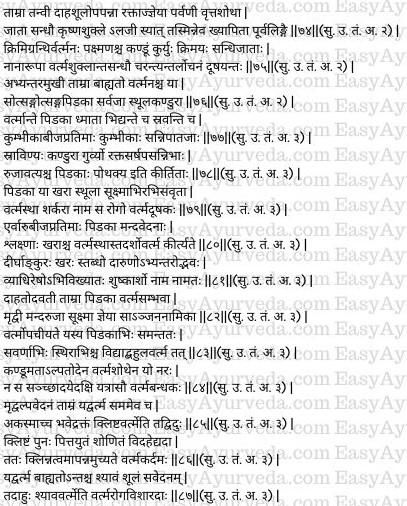
Parvani and Alaji
Parvani – A rounded swelling of coppery (red) colour, thin (small), associated with burning sensation and pain, caused by aggravated blood, developing at the junction of sclera and cornea is known as Parvani.
Alaji – Another identical disease known as Alaji occurs at the same place i.e. at the junction of sclera and cornea, will have the symptoms of the disease alaji which has already been described (under Prameha Pidaka). (74)
Krimigranthi
The micro-organisms which are produced at the corners of the eyes (inner and outer angles of the eye) on reaching the eyelids and eyelashes produce itching therein. These organisms are of different kinds. They move around and on reaching the junction between eyelids and the white of the eye (sclera), they also gain entry into and contaminate the inside of the eye. This disease is known as Krimigranthi. (75)
Read – Blepharitis: Inflamed Eyelids Ayurvedic Treatment, Remedies
Utsangini / Utsanga Pidaka
A cyst is formed on the outer side of the eyelid with its opening pointed inwards into the eye, is coppery (red) in colour, covered by many small cysts (papules), elevated (big in size), with severe itching and caused by increase of all three doshas together is called as Utsangini or Utsanga Pidaka. (76)
Kumbhika
Multiple papules of the size of seeds of kumbhika formed on the margins of the eyelids, which get swollen and burst open repeatedly and produce discharges, caused by increase of all the three doshas together is known as Kumbika. (77)
Pothaki
A disease in which many papules are formed inside the eyelids, which has discharges, itching, is heavy (hard), resembling (size of) red mustard seeds, and has pain is known as Pothaki. (78)
Read – Pothaki, Klishtavartma Eye Disorders – Symptoms, Treatment
Vartmasarkara
A rough and hard papule, surrounded by many smaller ones inside the lids, is known as Vartmasarkara. This disease causes distortion of eyelids. (79)
Arsovartma
A papule which resembles a seed of a melon, is slightly painful, unctuous (smooth), rough and is caused either inside or outside or obth sides of the eyelid is known as Arshovartma. (80)
Read – Arshovartma, Shushkarsha Eye Disorders – Symptoms, Treatment
Suska Arsas
A papule comprising of long sprouts, rough, stiff (hard), immovable, very troublesome (painful) and arising from deep inside the eyelid is known as Suska Arsas. (81)
Anjana Namika
A papule associated with burning sensation, pricking pain, coppery (red) coloured, occurring inside the eyelid, is soft, with mild pain, and small in size is known as Anjana Namika. (82)
Bahula Vartma
The disease in which the eyelid becomes with numerous hard papules which are of the same colour of the surrounding skin (not discoloured) developing inside the eyelid is known as Bahulavartma or Bahalavartma. (83)
Vartma Bandhaka
The disease in which eyelids get swollen being associated with itching and mild pricking pain and the person is unable to cover the eye (with the lids) i.e., unable to close the eyes properly is known as Vartma Bandhaka. (84)
Klista Vartma
The disease in which the eyelids become soft, slightly painful, and coppery red in colour and even and the eyelids suddenly become angry red without any apparent reason is known as Klista Vartma. (35)
Vartmakardama
In the same Klista Vartma disease (mentioned above) when increased pitta associated with rakta (blood) causes burning sensation, the lids become moist. This condition is called as Vartmakardama. (86)
Syava Vartma
The disease in which the eyelids become blackish blue both inside and outside, gets swollen and becomes painful is called as Syavavartma by experts. (87)
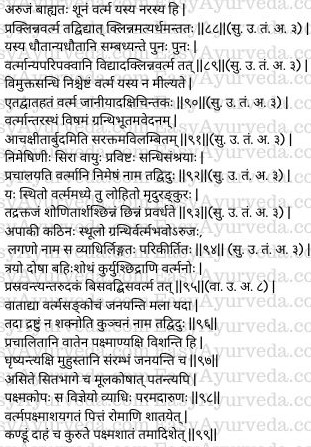
Praklinna Vartma
The disease in which the eyelids are swollen and painless from outside (externally) but the inside of the lids is moist with discharges is known as Praklinna Vartma. (88)
Aklinna Vartma
A disease in which the lids stick (together) to each other often whether they are washed with water or not and suppuration of the eyelids do not take place (lids show signs of unripe state – pus not being formed) is known as Aklinna Vartma. (89)
Vatahara Vartma
The disease in which the lids get displaced from their joints (junction between the eyelids and the white of the eyes – sclera) and becomes motionless and the person unable to close or open his eyelids is known by the experts as Vatahata Vartma. (90)
Vartma Arbuda
A cystic swelling (tumour) developing from inside the eyelids, irregular in shape, having mild pain (or painless), red coloured and quickly increasing in size is known as Vartmarbuda. (91)
Read – Vatahata vartma, Vartmarbuda Eye Disorders – Definition, Symptoms, Treatment
Nimesa
A disease in which the vata which has got increased gets lodged in the siras (veins, blood vessels) responsible for winking the eyes located in the junction of the eyelid and white of the eye (sclera) and causes too much of winking (blinking) of the eyelids is known as Nimesa. (92)
Sonitarsas (Raktarsas)
A disease in which red coloured soft sprouts develop at the centre of the inside of the eyelid, caused by increased rakta (blood) is known as Sonitarsa or Raktarsa. Thes sprouts continuously (again and again) keep growing even after they are excised. (93)
Lagana
A disease in which a non-suppurating, hard, big, painless cystic swelling (tumour) develops inside the eyelid is known as Lagana. (94)
Read – Lagana, Nimesha Eye Disorder – Symptoms, Treatment
Bisa Vartma
A disease caused by all the three doshas increased together, wherein a swelling is produced on the exterior (outside) of the eyelid, having many small openings through which watery discharges come out from inside the lids, just like from the stalk of a lotus flower is called by the name Bisa Vartma. (95)
Kuncana
A disease in which when vata and other doshas (pitta, kapha) undergo increase together and cause contractures of the eyelids leading to inability (of the person) to see things (due to inability to open the eyelids) is known as Kuncana. (96)
Paksmakopa
When the aggravated vata causes the eyelashes turned inwards into the eye, and causes friction on the eyeball repeatedly, and swelling of both white and black portions of the eye, and the hairs may also get dislodged from their roots and fall off. This dreadful disease is known as Paksmakopa. (97-98)
Read – Pakshmakopa (Trichiasis) Eye Disorder – Definition, Symptoms, Treatment
Paksmasata
A disease in which increased pitta located in the eyelids and lashes (junction of eyelids and eyelashes) makes the eyelashes to fall off from their roots (eyelids) and is associated with itching and burning sensation is known as Paksmasata. (99)
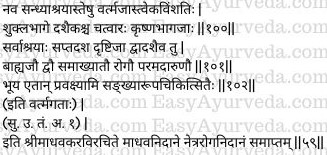
Compilation of all the eye diseases
(So far have been described nine diseases of joints of the eye, twenty-one diseases of the eyelids, eleven diseases of the white of the eye i.e. sclera, four diseases of the black portion of the eye, seventeen diseases occurring in the entire eye, twelve diseases of the vision and two external diseases of the lashes which are dreadful in nature).
Thus ends the chapter on Netra Roga Nidanam in Madhava Nidana text written by Acharya Madhavakara.











